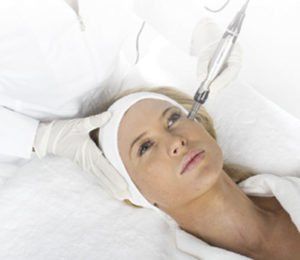Mechanical Exfoliation Vs. MicroNeedling
- By J.Maxine MacGwyre, LMA, Nutrition Specialist
- •
- 12 Apr, 2019
- •

…Defining the Difference
Derma this, Micro that…confusing? The variety of treatments, devices and products available to aestheticians for skin rejuvenation can be daunting to many clients who are seeking to select the most appropriate treatment for their skincare needs and goals. Which will be most effective and which may just be the latest gimmick? Buyer beware takes on a whole new meaning in the world of Google…information overload has officially arrived! The key to skin rejuvenation—whether it is mechanical exfoliation, chemical exfoliation, laser, LED light therapy or MicroNeedling, also known as Collagen Stimulating Therapy—is maintaining the integrity of skin structures while stimulating cellular renewal and increasing the production of matrix proteins, such as collagen and elastin, to improve skin health.
Microdermabrasion is one of the top five nonsurgical mechanical exfoliation procedures performed, according to the American Society for Aesthetic Plastic Surgery.¹ Although this service was originally performed by dermatologists, it is now the most popular exfoliation method used by aestheticians. Microdermabrasion refers to the mechanical exfoliation of the superficial layers of the epidermis using aluminum oxide crystals providing a sandblasting effect or alternatively a rough surface made of ground diamonds on the tip of a tool (called a diamond tip) which provides a sandpaper type of effect; both variations utilize suction for stimulation and removal of dead skin cells. Microdermabrasion was developed in Italy and gained wide popularity in Europe in the mid-1980s before making its way to the United States in the mid-1990s.
Today there are several methods of microdermabrasion available. The original devices were developed using aluminum oxide crystals as the means of exfoliation. Although aluminum oxide works effectively for exfoliation, there has been some controversy regarding the potential hazards of using aluminum on the skin. Alternatively, the use of sodium bicarbonate crystals is becoming the material of choice for crystal microdermabrasion due to its organic nature and smooth texture. Overall one of the largest downsides of the crystal microdermabrasion treatments are the limitations in treating close to the eye area due to the potential hazard of getting crystals in the eye.
Another development that came about in 1999 is the use of a diamond-tip or particle-free microdermabrasion machine. The diamond-tip provides similar results to the crystal method. The diamond-tip does not leave behind crystals, reducing the risk of side effects such as eye abrasions.

MicroNeedling, or Collagen Stimulation Therapy, is hands down, the go-to treatment for skin rejuvenation. The difference between this treatment and the other methods mentioned in this blog is that there is no removal of the outer layers of skin. The premise of MicroNeedling is to create a controlled wound response also known as the Inflammation Response in the skin which in turn will stimulate growth factors, collagen and elastin. Skin-needling was first recognized in 1995 when Drs Norman and David Orentreich, MD, used dermal needling as a method to repair scars. The following year, Des Fernandes, MD, put his spin on the treatment and introduced a stamp like needling device as a method of skin rejuvenation. Soon thereafter, Fernandes developed a dermal roller (a drum like rolling device with protruding needles).²
Over the last decade, the newest and most effective MicroNeedling devices to enter the market have been automated needling devices known as pens. As with anything, some devices are more effective and most importantly incorporate safety features such as those ensuring there is no cross contamination of fluids from one client to the next… not all devices are created equally! Pens provide a more consistent treatment through vertical insertion of needles, reducing the risk of the micro tearing of the skin associated with rollers. The automated needling systems also allow for the customization of needle depth and speed which can be selected by the aesthetician to address the specific treatment areas.
MicroNeedling is most commonly used for fine lines, wrinkles, acne scarring, pigmentation, stretch marks and mild forms of rosacea. Microneedling, as stated previously, does not physically remove the outer layers of skin, but instead stimulates growth factors to strengthen capillary walls, decrease inflammation, enhance collagen production and increase product penetration directly post treatment via micro-channels created during the procedure.
Endless possibilities…don’t get overwhelmed
The possibilities for skin rejuvenation are endless; from home care products and professional treatments to surgical procedures. One of the most efficient ways to demystify the maze of options is to align yourself with a trusted skincare professional who keeps current in the industry by way of continuing education to provide the best guidance as to the most appropriate treatment path for your specific needs based on established skincare goals, which is determined through a comprehensive skin analysis.
References
- surgery. org/ media/ news-releases/ cosmetic-procedures-increase-in-2012(Accessed July 8, 2013)
- L Setterfield, The Concise Guide to Dermal Needling, Virtual Beauty Corporation, Whangaparaoa, New Zealand (2010)




